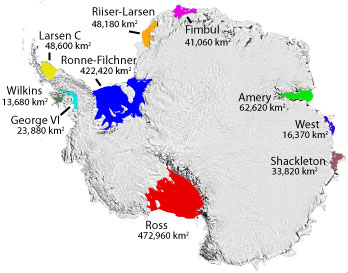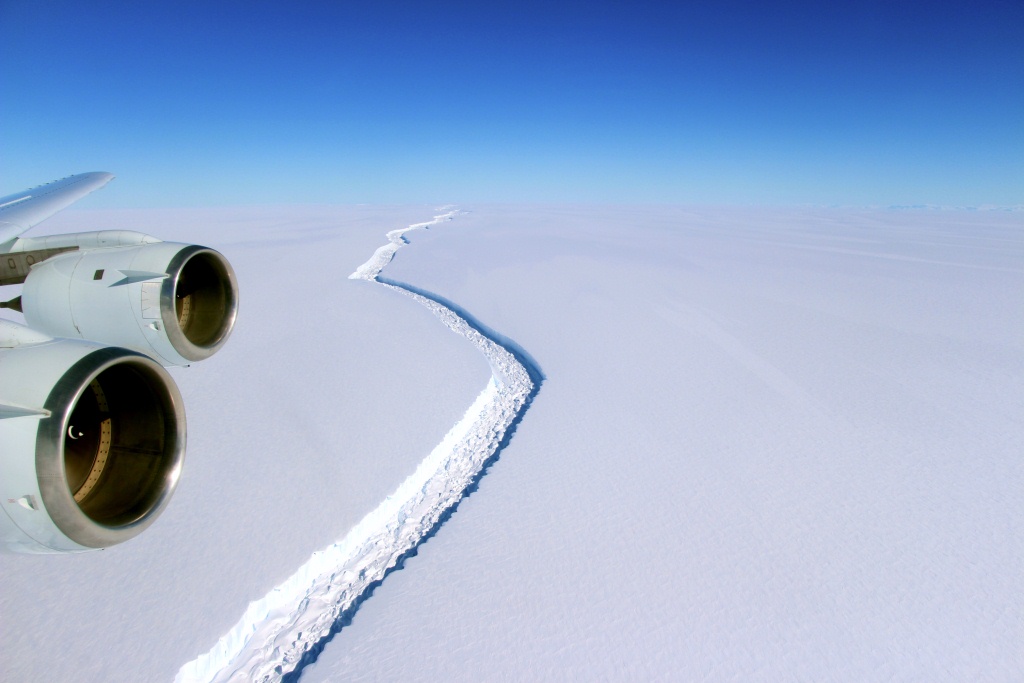A huge iceberg size of Delaware is poised to break-off from Antarctica. The consequences of this vast iceberg breaking off are still unknown, but scientists claim it will impact the collapsing of an ice shelf in years to decades.
These dramatic changes are happening in the Larsen C ice shelf. The Larsen C ice shelf is the most northern major ice shelf and the fourth largest ice shelf in Antarctica. It is about 350m thick and floats on the seas at the edge of West Antarctica, holding a significant amount of continent’s ice. It is also holding back the flow of glaciers that feed into it.

Major Antarctic Ice Shelves
The huge rift in the Larsen C ice shelf on the Antarctic Peninsula has been present for decades.
But in December last year, the rift expanded rapidly. It has grown by about 11(18 km) miles and now it is more than 49 (80) miles long.
And now there is just 12,5 km (20 km) of ice keeping the piece of floating away. What will become a massive iceberg is 1,930 square miles (5,000 square km) big. That puts the iceberg among the top 10 biggest that have been recorded.
Iceberg breaking off will impact the entire Larsen C ice shelf
Researchers have been tracking the rift in Larsen C for many years. Several ice shelves have cracked up around northern parts of Antarctica in recent years. The Larsen A ice shelf collapsed in 1995 and the Larsen B shelf disintegrated in 2002. The researchers have thoroughly observed and tracked this ice shelf since then. Unfortunately, there is not much it can be done to keep it from breaking off.
Researchers based in Swansea say the loss of this ice piece will fundamentally change the landscape of the Antarctic Peninsula. “If it doesn’t go in the next few months, I’ll be amazed,” project leader Prof Adrian Luckman, from Swansea University, told BBC News.
“There hasn’t been enough cloud-free Landsat images but we’ve managed to combine a pair of ESA Sentinel-1 radar images to notice this extension, and it’s so close to calving that I think it’s inevitable.”
It’s normal for ice shelves to produce an iceberg every few decades. But the rapid growth of the Larsen rift has left the researchers concerned about how quickly the rest of the ice shelf will follow suit once it’s gone. They think that this iceberg break off will leave the whole shelf vulnerable to future break-up. They are convinced that the remaining ice shelf will be less stable than the present one.
“We would expect in the ensuing months to years further calving events, and maybe an eventual collapse – but it’s a very hard thing to predict, and our models say it will be less stable; not that it will immediately collapse or anything like that”, Professor Luckman said.
Ocean level could rise by 10 cm
Since it floats on the sea, the collapsing of this iceberg it doesn’t directly contribute to sea level rise. Researchers are concerned when it comes to glaciers held by the Larsen C ice shelf.
But if the shelf breaks up, it could result in glaciers that flow off the land behind it to speed up their passage towards the ocean. Huge volumes of ice would enter the ocean and that would be associated with the sea-level rise. If that happens, it is estimated that ocean levels around the planet would rise by 10cm.




